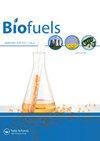固定化脂肪酶催化植物油酯交换制备生物柴油的研究进展
IF 2.6
4区 工程技术
Q3 ENERGY & FUELS
引用次数: 0
摘要
本文章由计算机程序翻译,如有差异,请以英文原文为准。
Transesterification of vegetable oils into biodiesel by an immobilized lipase: a review
Abstract The goal of biodiesel production is to obtain a clean, biodegradable, and renewable fuel. Industrial-scale processes use homogeneous and heterogeneous chemical catalysts. These are efficient but require the use of very pure reagents and complex product purification steps or processing conditions under high temperature and pressure. Enzymatic catalysis, in contrast, using lipases as biocatalysts, is an alternative that produces a better-quality product under less extreme conditions. Since free lipases are not reusable, it is necessary to immobilize them to stabilize them and allow their reuse over several reaction cycles. This informative review presents various methods of lipase immobilization (physical adsorption, ionic bonding, covalent bonding, entrapment, encapsulation, and cross-linking) as well as their advantages and disadvantages, followed by a comparative study. Articles from 2010 to 2022 were used for bibliometry to show that the topic is still relevant. The immobilization methods are classified into two main groups, physical and chemical, according to the enzyme-support interaction. Among these methods, ionic bonding is recommended, because in addition to this process being easily achievable, lipases immobilized this way are more stable and reusable. In summary, the production of biodiesel from immobilized lipases is in line with sustainable development and respect for the environment.
求助全文
通过发布文献求助,成功后即可免费获取论文全文。
去求助
来源期刊

Biofuels-Uk
Energy-Renewable Energy, Sustainability and the Environment
CiteScore
5.40
自引率
9.50%
发文量
56
期刊介绍:
Current energy systems need a vast transformation to meet the key demands of the 21st century: reduced environmental impact, economic viability and efficiency. An essential part of this energy revolution is bioenergy.
The movement towards widespread implementation of first generation biofuels is still in its infancy, requiring continued evaluation and improvement to be fully realised. Problems with current bioenergy strategies, for example competition over land use for food crops, do not yet have satisfactory solutions. The second generation of biofuels, based around cellulosic ethanol, are now in development and are opening up new possibilities for future energy generation. Recent advances in genetics have pioneered research into designer fuels and sources such as algae have been revealed as untapped bioenergy resources.
As global energy requirements change and grow, it is crucial that all aspects of the bioenergy production process are streamlined and improved, from the design of more efficient biorefineries to research into biohydrogen as an energy carrier. Current energy infrastructures need to be adapted and changed to fulfil the promises of biomass for power generation.
Biofuels provides a forum for all stakeholders in the bioenergy sector, featuring review articles, original research, commentaries, news, research and development spotlights, interviews with key opinion leaders and much more, with a view to establishing an international community of bioenergy communication.
As biofuel research continues at an unprecedented rate, the development of new feedstocks and improvements in bioenergy production processes provide the key to the transformation of biomass into a global energy resource. With the twin threats of climate change and depleted fossil fuel reserves looming, it is vitally important that research communities are mobilized to fully realize the potential of bioenergy.
 求助内容:
求助内容: 应助结果提醒方式:
应助结果提醒方式:


